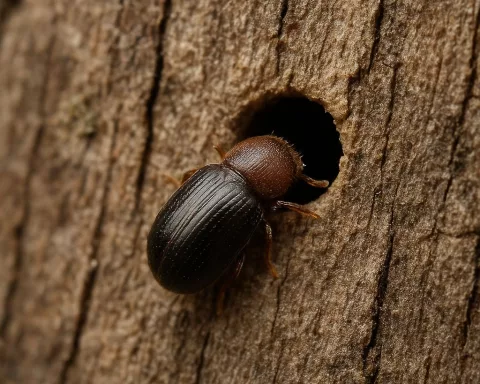Rabies is now a serious threat to Cape Fur Seals, once seen as graceful ocean dwellers. Symptoms like aggression, confusion, foaming at the mouth, and paralysis signal the deadly disease’s presence. A recent shocking video shows a seal acting strangely, raising alarms among scientists. This marks a new danger for marine life, as rabies usually affects land animals. To fight back, researchers are launching a campaign to understand and protect these seals, reminding us how fragile our ocean ecosystems can be.
What are the symptoms of rabies in Cape Fur Seals?
Rabies in Cape Fur Seals presents several severe symptoms, including:
- Aggressive Behavior: Sudden hostility towards objects and animals.
- Disorientation: Confusion and uncoordinated movements.
- Excessive Salivation: Foaming at the mouth.
- Unusual Vocalizations: Distressing cries and barks.
- Paralysis: Progressively affecting limbs leading to death.
Understanding these symptoms is crucial for marine safety and conservation.
Intrusion of Rabies into Marine Life
In the dynamic world of marine ecosystems, seals have long epitomized grace and fluidity, navigating the ocean’s currents with an inherent elegance. However, this serene picture has recently been disturbed by a video released by Sea Search, highlighting a startling new threat. The footage captures a Cape Fur Seal exhibiting abnormal and erratic behavior, prompting alarm among wildlife experts. This unusual activity points to a rare but lethal concern: rabies. Typically associated with land mammals, this viral menace is now making a worrying appearance in marine environments, causing both curiosity and alarm among scientists and conservationists.
Rabies is infamous for its devastating effects on the central nervous system of mammals. The virus’s incursion into marine life represents a new frontier in the study of zoonotic diseases, urging a closer examination of its impact on these aquatic creatures. The emergence of rabies among seals has triggered a wave of scientific investigation, aiming to deepen our understanding of how such a virus can cross from terrestrial to marine habitats and what this means for the broader ecosystem.
A Rare Phenomenon Gains Ground
Traditionally, rabies has been a major concern for land-based animals like mongooses, jackals, and foxes. Seals, on the other hand, have largely been exempt from this threat. However, recent data shows a troubling rise in rabies cases among seals. Historically, rabies was introduced to Africa by dogs around 1892, with a significant spread occurring in the 1950s, affecting various wildlife species. Despite this long history, the first confirmed case of rabies in a marine mammal was not documented until June 2024, thanks to brain samples collected by Sea Search.
The disturbing video, titled “This is what rabies looks like in a Cape Fur Seal,” reveals an infected seal demonstrating a host of distressing symptoms. The infected animal displayed aggression, disorientation, excessive salivation, unusual vocalizations, and eventually, paralysis. This behavior is a stark departure from the seal’s usual peaceful demeanor, necessitating euthanasia by a qualified professional.
Clinical Manifestations: A Grim Reality
Rabies presents itself in seals much as it does in other mammals, with a range of severe symptoms that escalate quickly, each marking the disease’s relentless progression:
- Aggressive Behavior: Normally docile seals may suddenly turn hostile, attempting to bite objects, other animals, or even humans. This aggression is a significant and alarming change from their typical behavior.
- Disorientation and Uncoordinated Movement: Infected seals often appear confused and struggle to move properly, leading to erratic and unpredictable actions that can be dangerous for both the animal and those around it.
- Excessive Salivation or Foaming at the Mouth: Known as one of the hallmark symptoms of rabies, increased salivation or foaming at the mouth is a clear indicator of the infection’s severity.
- Unusual Vocalizations: Rabid seals may emit unsettling cries or barks, adding a haunting auditory element to their visible distress.
- Paralysis: As the disease advances, affected seals may experience limb paralysis, which is a precursor to their eventual death.
The Zoonotic Threat
Rabies is a zoonotic disease, meaning it can be transmitted from animals to humans. If a person were to be bitten or scratched by a rabid seal, the virus could be passed on, requiring immediate medical intervention. This potential for transmission underscores the importance of vigilance and precaution for anyone interacting with marine life. Other animals, both marine and terrestrial, such as dogs, otters, and even dolphins, also run the risk of contracting the virus if they come into contact with an infected seal.
Although the likelihood of human infection from a rabid seal is relatively low, marine biologists and veterinarians emphasize the need to avoid any seal exhibiting abnormal behavior. Individuals bitten or exposed to the saliva of a possibly rabid seal should seek medical assistance immediately and undergo post-exposure prophylaxis (PEP) to prevent the virus from taking hold.
A Call to Action: Research and Surveillance
In light of this emerging threat, Sea Search has initiated a new campaign titled “Seal Rabies: Research and Surveillance.” This effort aims to channel funding and resources into understanding and combating rabies in marine mammals. The campaign is designed to support the ongoing work of researchers and staff who are tirelessly endeavoring to unravel the complexities of this disease and develop effective solutions.
The appearance of rabies among Cape Fur Seals is a stark reminder of the intricate interconnectedness of our ecosystems and necessitates a proactive approach to research and conservation. This development calls for a heightened awareness of the evolving challenges faced by wildlife in our changing world. By delving deeper into our scientific knowledge and strengthening our conservation efforts, we can aspire to navigate these uncharted waters and protect the delicate equilibrium of marine life. Through dedicated research and unwavering commitment to conservation, we can hope to safeguard the future of our oceans.
“`markdown
FAQ: Rabies in Cape Fur Seals
What are the symptoms of rabies in Cape Fur Seals?
Rabies in Cape Fur Seals presents several severe symptoms, including:
– Aggressive Behavior: Sudden hostility towards objects and animals.
– Disorientation: Confusion and uncoordinated movements.
– Excessive Salivation: Foaming at the mouth.
– Unusual Vocalizations: Distressing cries and barks.
– Paralysis: Progressively affecting limbs leading to death.
Understanding these symptoms is crucial for marine safety and conservation.
How has rabies impacted Cape Fur Seals?
Rabies, traditionally a concern for terrestrial animals, has recently become a serious threat to Cape Fur Seals. The emergence of rabies among these marine mammals signifies a new danger for ocean ecosystems, prompting urgent scientific investigation into how the virus can cross from land to sea.
What should I do if I encounter a seal exhibiting abnormal behavior?
If you encounter a Cape Fur Seal displaying abnormal behavior, it is essential to maintain a safe distance and avoid any interaction. Individuals bitten or exposed to a possibly rabid seal should seek medical assistance immediately and undergo post-exposure prophylaxis (PEP) to prevent the virus from taking hold.
How can rabies be transmitted from seals to humans?
Rabies is a zoonotic disease, meaning it can be transmitted from animals to humans. The virus can be passed on if a person is bitten or scratched by a rabid seal. While the risk of human infection is relatively low, it is vital to be cautious and avoid contact with seals that exhibit unusual behavior.
What are the broader implications of rabies in marine ecosystems?
The appearance of rabies among Cape Fur Seals highlights the interconnectedness of ocean ecosystems and raises concerns about the potential impact on other marine and terrestrial species. This situation urges a closer examination of zoonotic diseases and their implications for wildlife conservation and public health.
What initiatives are being taken to combat rabies in marine mammals?
Sea Search has launched a campaign titled “Seal Rabies: Research and Surveillance,” aimed at funding and supporting research into rabies among marine mammals. This initiative seeks to deepen understanding of the disease and develop effective solutions to protect Cape Fur Seals and maintain the balance of marine ecosystems.
“`












